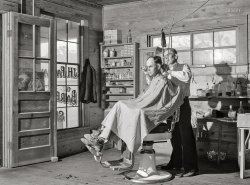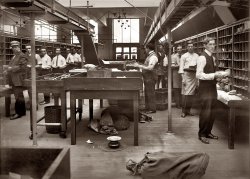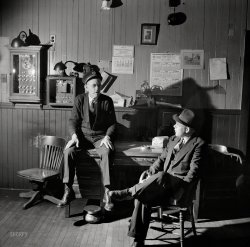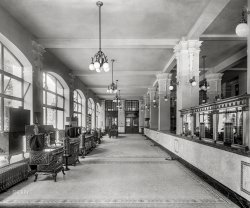
MAY CONTAIN NUTS

Search Shorpy
SHORPY ART

Framed or unframed, desk size to sofa size, printed by us in Arizona and Alabama since 2007. Explore now.
Join and Share
Ad-Free Shorpy
Shorpy is funded by you. Patreon contributors get an ad-free experience.
Learn more.

Recent comments
- Freeze Frame
- Texas Flyer wanted
- Just a Year Too Soon
- WWII -- Replacing men with women at the railroad crossing.
- Yes, Icing
- You kids drive me nuts!
- NOT An Easy Job
- I wonder
- Just add window boxes
- Icing Platform?
- Indiana Harbor Belt abides
- Freezing haze
- Corrections (for those who care)
- C&NW at Nelson
- Fallen Flags
- A dangerous job made worse
- Water Stop
- Passenger trains have right of way over freights?
- Coal
- Never ceases to amaze me.
- Still chuggin' (in model form)
- Great shot
- Westerly Breeze
- For the men, a trapeze
- Tickled
- Sense of loneliness ...
- 2 cents
- Charm City
- What an Outrage
- Brighton Park
Member Photos
The Shorpy
Print Emporium
Print Emporium
Search Shorpy
Search results -- 30 results per page
- The Artsy Hearth: 1906
- ... View full size.
Great Expectorations The spittoon behind the rocker on the right is decidedly cleaner than others we ... Posted by Dave - 07/29/2012 - 1:32pm -
![The Artsy Hearth: 1906 Crawford Notch, New Hampshire, circa 1906. "Fireplace, Crawford House." 8x10 inch dry plate glass negative, Detroit Publishing Company. View full size.
Great ExpectorationsThe spittoon behind the rocker on the right is decidedly cleaner than others we have seen recently.
Don't forget your keys!So there's a key in the kinda-sorta keystone of the fireplace, and a Greek key meander pattern in the hearth rug. Coincidence, or are the furnishings nagging me, again?
What the heck is that light?What in tarnation is that light fixture? It can't be electric; it has a chimney. Is it gas? Why are there two control chains?
Also note the key in the key-stone. I think it's an example of early 20th-century brick-laying humor.
[The chains are for gas on and gas off. And I guess more gas/less gas. - Dave]
Odd place for a sinkTo the right of the fireplace.
Hearth HygieneSo what's with the sink and soap dispenser to the right? It looks like they cut out a part of the wall later and added a sink. Is this a room or the lobby?
I came for the waters.At first I thought that the strange little alcove to the right of the fireplace was a lavabo for hand washing, such as one might find in a corner of a 19th Century commercial dining room. But, no. The LOC's highest resolution scan adds a bit more clarity to the wheel-cut lettering on the globe, and it appears that this is a "brand-name" spring water dispenser for the convenience of the hotel guests. The little sink below has a glass tumbler, and the legible words on the globe are "Spring Water." I can't quite make out the proper name, though. Not Lithia and not Poland. Perhaps Merritt?
Sit Down and Stay AwhileMaybe I'm crazy, but this scene looks pretty inviting to this Southern boy, especially if I was up in New Hampshire on a cold winter day and this fireplace was serving its purpose. I love the intricacies of the masonry, the wallpaper, the decorations. I'm guessing a colorized version of this photo would be amazing.
Lady of the ManorI am guessing the ghostly image behind the chair on the right is the lady of the house hovering. I wish they would try to get the wrinkles out of that carpet.
Wonderful piece of (my!) historyMy great-great-grandfather Asa Barron bought Crawford House in the 1870s. I've never seen any interior photos before now! Thanks so much for putting it up.
The LadyThe lady at the edge of the frame has a quality that is almost like a portrait to the point where I wonder if it might indeed be a painting.
The fireplace was there until the endSome photos of the abandoned Crawford House taken in 1977. The fireplace can still be seen in one of them. Shortly after the building was destroyed by fire.
(The Gallery, DPC)](https://www.shorpy.com/files/images/4a22047a.thumbnail.jpg)
- Grand Palace: 1921
- ... - Dave]
Top 10 Grand Palace details 10. Spittoon
9. One point perspective
8. Baseball magazine ... Posted by Dave - 08/06/2012 - 1:57pm -
![Grand Palace: 1921 Washington circa 1921. "Grand Palace shoe shining parlor, 719½ 14th St. N.W." National Photo Company Collection glass negative. View full size.
Deep, dark mysteries I can clearly remember storefronts in downtown Providence, Rhode Island, that were very similar to this as late as the early 1960's. They'd be deep, dark, somewhat run down -- and I'd often see men's faces, far inside, staring back at me when I looked in. Smoke, shoeshine and magazine stores like this were often combined and it was understood that they were for men only, not kids or "nice" women. I suspected that, much deeper, toward the rear, other sorts of magazines, of particular interest to men, were available upon request, but by the time that I became old enough (and courageous enough) to consider venturing inside, they'd all gone the way of the dinosaur.
We Clean Your Hat
Men's MagsAmong others The National Police Gazette, Field and Stream, The Ballplayers' Chronicle, Sporting Life were all being published during this time.
[I'm pretty sure those aren't quite the kind of men's mags Mattie was referring to. - Dave]
The booth in the backSo you took off your suit and sat in a "private booth" while it was pressed? I guess you whiled away the time by reading those magazines of particular interest to men.
[Which in 1921 would have been what, I wonder. National Geographic? - Dave]
Top 10 Grand Palace details10. Spittoon
9. One point perspective
8. Baseball magazine
7. Hat window illustration
6. Lighting inside
5. Light fixtures
4. Shiny shiny shoes
3. Mosaic threshold
2. Uniform, hat on shoeshine
1. Bob Dobbs lookalike upper right
Image is everythingI find it amazing that in a time where access to personal hygiene was somewhat limited, men accorded so much importance to their exterior appearance.
Shoe shine, pressed suit, well formed hat ... even many of the boys working in Hine pictures tried their best to dress like "little men."
Grand Tile entranceOne symbol of permanence is the tile entrance, which looks like it's being guarded by Joe Pesci.
Too bad there aren't more of those places anymore; just a plain, simple building with one mission: keeping the men looking sharp. In my town, the only thing I can think of that comes close to the experience of this place would be a barbershop. Although he won't use the straight razor for shaving, he still uses a hand-held electric scalp massager from 1920.
Eight-pagersIf you had the password or got an OK from somebody known as a customer, "Tijuana bibles" and other "literature" could probably be had under the counter. It certainly worked that way a few years later in most towns.
Dirty SidewalkWhy do you suppose the sidewalk is dirty in front of this place, but clean in from of the Kase cigar store? Perhaps Kase's scrubbed their sidewalk often? Or maybe the shoeshiners were pretty messy and often got polish on the soles of shoes. Or it could be tobacco or cigar tips spit on the sidewalk. Still, these guys never cleaned their sidewalk like the neighbors did.
[There's an easy answer to that question if you look carefully. Or even not so carefully, as long as you look up. - Dave]
So, when it rains, it rains scum instead of water? It's hard to believe that the awning on the right would make a difference of that magnitude, unless the B&W film is deceiving and what looks like dark dirt/scum is really just wet sidewalk.
[Below, the sidewalk the same day before it rained. - Dave]
First impressionsLike the other commenters, I saw this as a men only kind of place - then I noticed the sign offering Altering and Repairs for Ladies & Gents. So, who knows?
(The Gallery, D.C., Natl Photo, Stores & Markets)](https://www.shorpy.com/files/images/30282u0_0.thumbnail.jpg)
- Country Barber: 1941
- ... his shop very well. What's missing in this shop is a spittoon.
Jep Jeptha Howard Parham was born in Georgia on June 23, 1886, ... Posted by Dave - 06/28/2021 - 4:35pm -

- Dear Sirs: 1902
- ... "Miss Jones. Take a letter. And after that, freshen up my spittoon."
Snip! This is a potpourri of office nostalgia.
My eyes ... Posted by Dave - 09/25/2012 - 4:22am -
![Dear Sirs: 1902 Circa 1902. "Richmond & Backus Co. office, Detroit." Our sixth glimpse behind the scenes at this printing, binding and office supply business. View full size.
Nice Corner Office"Miss Jones. Take a letter. And after that, freshen up my spittoon."
Snip!This is a potpourri of office nostalgia.
My eyes spotted that pair of banker's shears hanging on a hook under the window sill. They were originally used by tellers to cut local currency from large sheets for customers. I used them in the news business to cut columns out of newspapers with just one, maybe two, snips.
They're not found today in big box office supply stores.
Take a Letter"Take a letter, Maria. Address it to my wife ... "
Yours trulyBoss: "Miss Jones, Please read that back to me."
Miss Jones: "How can I read it back? It's in shorthand."
(The above was an old shorthand teacher's joke in 1955 as it is easier to write in shorthand than it is to read it back. I learned the Gregg method, not the Pitman).
Nice officeI bet they didn't have casual Fridays. There is so much to look at in this photo. Mind-boggling how offices have changed.
1903?Does that calendar on the window say 1903? No one spotted that? You guys are slipping...lol
[A common full-year calendar format of the time also printed the first six months of the following year; that's what's below the 1903...roflmao. -tterrace]
(The Gallery, Detroit Photos, DPC, The Office)](https://www.shorpy.com/files/images/SHORPY_4a20423a.thumbnail.jpg)
- The Office: 1913
- ... glass negative, George Grantham Bain Collection. Note the spittoon.
Postal jargon I'm not up on my history of postal jargon, but ...
Target Practice Lots of overspray around the ol' spittoon.
Railway mail service Was where my uncle worked in the 40's, ... Posted by Dave - 08/19/2012 - 1:52pm -

- Obelisk Flour: 1901
- ... but now a highly collectable piece of ephemera--a horse spittoon!
Ah, but I jest.
This is actually a small flip-top fire ... Posted by Dave - 08/30/2020 - 4:59pm -
![Obelisk Flour: 1901 Washington, D.C., circa 1901. "View of E Street S.W., north side, looking east from Delaware Avenue, showing a grocery store on the corner." 5x7 inch glass negative. View full size.
PearlinePearline was a powdered soap (thanks, Google) Best By Test was their tagline and they really pushed it.
Mystery ObjectNear the curb, to the left of the image, is a once commonplace city streetside fixture, but now a highly collectable piece of ephemera--a horse spittoon!
Ah, but I jest.
This is actually a small flip-top fire hydrant. Here is an image featuring the same type at the Historical Society of Washington, D.C. website: D.C. hydrant
At aforementioned website, you can enter 'hydrant' under Keyword Search to discover additional images of the flip-top hydrant, including at least one image showing one 'flipped'.
High Grade foodSomehow that "High Grade Butter and Cheese" sign makes my mouth water. I'll bet the flavors were better than we get today.
Fels Naptha is still around!Who knew? And it helps with poison ivy.
What's that pot?Some Shorpyite will surely know what that cast-iron pot is on the curb to the left. Only thing I can think of is that it's a receptacle for folks picking up after their horses.
[It's a fire hydrant, as seen in the comments under this post from 2008. - Dave]
Obelisk Flour - ReliableIt will always rise to the occasion.
Little kid in the streetTo the list of interesting things Shorpy commenters love to note about street scenes, you can add to horses and wagons and electric cars and horse apples and mysterious objects at the curb and intriguing configurations of streetcar tracks: children wandering aimlessly in the road.
E is for ElmIn about 25 years all those elm trees lining E street will die from Dutch elm disease
Pettijohn's Breakfast Foodgave oatmeal a run for its money in those days, until Quaker Oats scooped it up in the mid-1920's. An 1897 ad assured the customer that it was made from only the finest Pacific Coast wheat, with all the nerve and strength-giving qualities carefully retained.
(The Gallery, D.C., D.C. Street Survey, Kids, Stores & Markets)](https://www.shorpy.com/files/images/SHORPY-40242a.thumbnail.jpg)
- Wired: 1921
- ...
Ping Of course no desk is complete without a spittoon.
(Technology, The Gallery, D.C., Natl Photo, The Office) ... Posted by Dave - 09/13/2011 - 6:07pm -
![Wired: 1921 Washington, D.C., circa 1921. "Chesapeake & Potomac Telephone Co." National Photo Company Collection glass negative. View full size.
Phone CellsIt looks like there are a whole bunch of batteries involved in the operation of this telephone company. Surely a knowledgeable Shorpster knows this and can identify the other equipment in this fascinating photo.
Learn Telephone Repair!I think it's a classroom. The in-box on the desk is labeled "experiments," and those look like people studying rather actually working. I suspect the equipment you see is a small scale, and probably self-contained, telephone system used for teaching.
Family tree of wireThat wiring panel thing on the right wall is a direct ancestor of the wiring done for our new server at work.
A little nip between calls?What do you suppose is in that bottle on top of the bookcase?
[Ink. - Dave]
Floor covering by Walter Christallerin the "Central Place Theory" pattern.
The ThingThe thing under the table that looks like a giant ignition distributor -- what is it?
Telephony 101The banks of #6 ignitor cells on the top shelves appear to be wired up in groups of 30 cells (15 each in two rows front-to-back), which would make the necessary 48V to power a telephone system. They'd use batteries so the students could play around without breaking the actual phone system.
The thing at the left is a test set. I can make out the words OSCILLATOR and FILTER on the central switch bank. The round items at the top are early vacuum tubes, so it has actual electronics in it.
The wiring panel on the right appears to be part of infrastructure for the building. It connects to the main trunk lines via the fat cable in the middle, and the smaller wire pairs are for individual phones.
Those huge metal lumps under the table (in the middle of the photo) might be used for pressurization of buried cables.
Phone System PowerTelephone central offices are still battery powered but with wet cells, not the dry cells pictured above. The power to your land-line phone is 48 volts direct current. Ringing voltage is 105 volts alternating current (20 cycles).
The reason batteries are used is so the phone system can continue operating in the event of a power failure.
PingOf course no desk is complete without a spittoon.
(Technology, The Gallery, D.C., Natl Photo, The Office)](https://www.shorpy.com/files/images/30160u.thumbnail.jpg)
- Ghost Lobby: 1910
- ... View full size.
High-class joint Nary a spittoon in sight.
Look closely And you will see the feint vision of ... Posted by Dave - 12/28/2012 - 10:32pm -
![Ghost Lobby: 1910 Circa 1910. "The Concourse, Fort William Henry Hotel, Lake George, New York." Please excuse any spectral guests who might happen to waft right through you. 8x10 inch dry plate glass negative, Detroit Publishing Company. View full size.
High-class jointNary a spittoon in sight.
Look closelyAnd you will see the feint vision of William Tecumseh Sherman.
[Sorry, no fencing in the lobby. - tterrace]
Why, didn't they wanna keep the goats out?
All the spirits seem EarthboundIf there were any floating about the ceiling then I'd be nervous.
Too much heat?The closest light fitting has a dirty big crack in the glass.
Footprints in Time!Love the footprints on the carpet, truly the marks of the ghosts of Fort William Henry!
All the senses This looks eerily like the great hall of the Schroon Lake Manor, in NY. It has been closed for 60 or more years, and possibly torn down by now, but, as a child, I roamed the grounds in wonder. Amazed at the ballrooms and grand theaters, something I have never seen since. What happened to our sense of grandeur, that we are complacent with miniature theaters and miniscule screens?
(The Gallery, DPC)](https://www.shorpy.com/files/images/SHORPY_4a25304a.thumbnail.jpg)
- Fire Chief: 1942
- ... from spreading. No doubt that leaning over to use the spittoon would put uneven loading on said legs.
Closer to home than i ... Posted by Dave - 08/14/2015 - 8:15am -

- Gas for the Masses: 1908
- ... on the totem pole got the unenviable job of cleaning the spittoon every day.
Spittoons One of my late bosses used to chew and ... Posted by Dave - 07/10/2019 - 3:24pm -
























